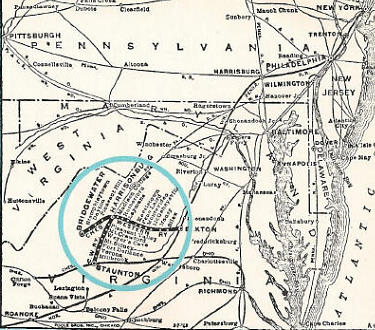ter. Making a long story short, Mr. Thomas solved
this dilemma by beating motor transportation at
its own game-flexibility-and the Chesapeake
Western became the first railroad in the United
States to offer free pick-up-and-delivery service
for less-carload freight shipments. This innovation
was an immediate success, and it gave the per-
sonnel of the Chesapeake Western a great deal
of pride later on to have the mighty Pennsylvania
Railroad pattern their pick-up-and-delivery ser-
vice after that established by the smaller road.
By 1938 the unproductive line west of Bridge-
water had been torn up, and all steam passenger
service was replaced by motor trains; the loss of
the open-pouch mail contract making it impera-
tive that train operating costs be pared to the
bone. Most important of all, General Manager
Thomas changed his title to that of President and
General Manager, having purchased the road
September 1, 1938.
No doubt the reader has been wondering about
the reference to Robert E. Lee in the title to this
article. The answer produces a most interesting
and little-known story. General Lee; revered by
Southerners and respected by Northerners down
through the years; in spite of many tempting of-
fers refused to lend his unblemished name to any
commercial enterprise when he retired to Lexing-
ton after the surrender at Appamattox-with one
notable exception-that being his acceptance of
the first Presidency of the Valley Railroad of Vir-
ginia. Recognizing the absolute necessity of a
railroad line running throughout the rich Shen-
andoah Valley, and having its terminus at the
Baltimore markets, General Lee permitted his
name to be used in connection with the new rail-
road. Shortly after construction started, control of
the line was acquired by the Baltimore and Ohio
Railroad and the line was subsequently opened
between Lexington and Baltimore. Surveys were
made and the line partially constructed from Lex-
ington south to Salem but this section was never
completed and about 1895 the B. & O. lost con-
trol of the segment between Harrisonburg and
Strasburg, leaving the portion from Harrisonburg

Map of the Chesapeake Western showing trunk line connections.
(where it crossed the Chesapeake Western) to
Lexington as a branch line completely severed
from the parent system. Obviously, this branch
could never be operated profitably, and finally,
after years of sizable losses, the Baltimore and
Ohio sold the old Valley Railroad of Virginia to
the Chesapeake Western Railway in 1942. To-
day, the Chesapeake Western operates over this
line from Staunton (where it connects with the
main line of the Chesapeake and Ohio Railway)
to Harrisonburg, where connection is made with
the Harrisonburg-Washington branch of the South-
ern Railway System and thence west and east
over the original main line of the Chesapeake
Western to Bridgewater and Elkton, respectively.
At Elkton, connection is made with the Norfolk
and Western Railway. This gives the C. W. a
total operated mileage of 53.5, and it performs
switching service for the Southern Railway at
Harrisonburg. The great majority of traffic han-
dled by the Chesapeake Western is received from
the N. & W. at Elkton, necessitating its being han-
dled over the most severe grades on the whole
railroad, located between Elkton and Harrison-
burg. Two of these heavy grades, each of which
is several miles long, average close to 2.0%
with segments appreciably higher. The maximum